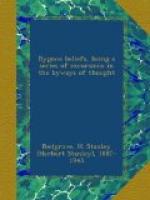What I may term systematised as distinguished from crude animism persisted throughout the Middle Ages. The work of systematisation had already been accomplished, to a large extent, by the Neo-Platonists and whoever were responsible for the Kabala. It is true that these main sources of magical or animistic philosophy remained hidden during the greater part of the Middle Ages; but at about their close the youthful and enthusiastic Cornelius Agrippa (1486-1535)[1] slaked his thirst thereat and produced his own attempt at the systematisation of magical belief in the famous Three Books of Occult Philosophy. But the waters of magical philosophy reached the mediaeval mind through various devious channels, traditional on the one hand and literary on the other. And of the latter, the works of pseudo-dionysius,[2] whose immense influence upon mediaeval thought has sometimes been neglected, must certainly be noted.
[1] The story of his life has been admirably told by Henry Morley (2 vols., 1856).
[2] These writings were first heard of in the early part of the sixth century, and were probably the work of a Syrian monk of that date, who fathered them on to dionysius the Areopagite as a pious fraud. See Dean INGE’S Christian Mysticism (1899), pp. 104—122, and VAUGHAN’S Hours with the Mystics (7th ed., 1895), vol. i. pp. 111-124. The books have been translated into English by the Rev. JOHN PARKER (2 vols.1897-1899), who believes in the genuineness of their alleged authorship.
The most obvious example of a mediaeval animistic belief is that in “elementals”—the spirits which personify the primordial forces of Nature, and are symbolised by the four elements, immanent in which they were supposed to exist, and through which they were held to manifest their powers. And astrology, it must be remembered, is essentially a systematised animism. The stars, to the ancients, were not material bodies like the earth, but spiritual beings. PLATO (427-347 B.C.) speaks of them as “gods”. Mediaeval thought did not regard them in quite this way. But for those who believed in astrology, and few, I think, did not, the stars were still symbols of spiritual forces operative on man. Evidences of the wide extent of astrological belief in those days are abundant, many instances of which we shall doubtless encounter in our excursions.
It has been said that the theological and philosophical atmosphere of the Middle Ages was “scholastic,” not mystical. No doubt “mysticism,” as a mode of life aiming at the realisation of the presence of God, is as distinct from scholasticism as empiricism is from rationalism, or “tough-minded” philosophy (to use JAMES’ happy phrase) is from “tender-minded”. But no philosophy can be absolutely and purely deductive. It must start from certain empirically determined facts. A man might be an extreme empiricist in religion (i.e.




